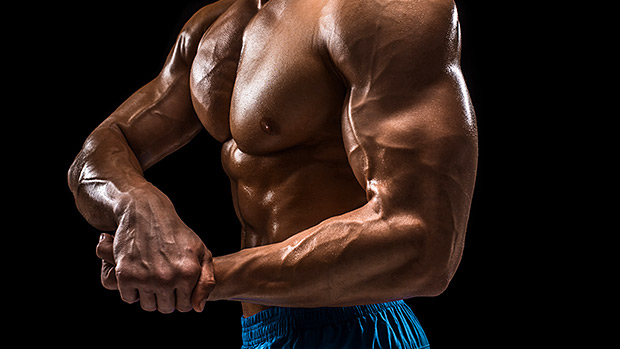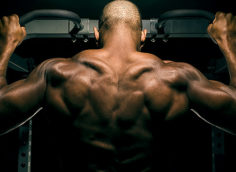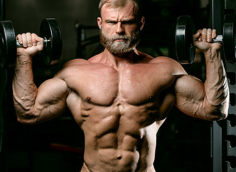You might, for some reason, find yourself unable to go to the gym. Are you doomed to devolve into the quintessential dad bod (or its female equivalent)?
No, of course not. While this might not be the perfect time to shoot for an IFBB pro card, there are plenty of things you can do to stay in good shape and improve your performance and aesthetics.
I already talked about how you can make bodyweight training more effective in a previous article. This time, I'll talk about other training modes you can use to improve yourself when there's not a gym in sight.
Bodyweight training, at least on the standard exercises (squats, push-ups, dips, chin-ups etc.), isn't going to be as effective as loaded resistance training for experienced lifters.
Most strong intermediate or advanced lifters will have an easy time with bodyweight exercises. Consider, for example, that when you do a push-up you're pressing roughly 60% of your body. If you weigh 185 pounds, it means that you're doing the equivalent of a 110-pound bench press. This would be a warm-up for most of us.
But it doesn't mean that bodyweight training is totally ineffective. If you look at some studies on light training, it appears possible to coax out at least some muscle growth when doing exercises with loads that might allow you to do 100 reps.
Some studies report inferior growth (but growth nonetheless), while others report growth equal to higher-weight resistance training. I discussed some of these studies in my article, The 100 Rep Leg Press.
Strength gains will of course be much smaller with light weight, high-rep training, but bodyweight training will still be good enough to slightly increase muscle mass.
What is critical, though, is that your bodyweight training must get into the pain zone if you want to eke some growth out. You need to bring on the lactate, which will lead to the release of growth factors.
You can do that by going to failure on very high reps (which can be boring) or you can use a few of these options below.
Isometrics refers to contracting a muscle without any joint movement, but "overcoming isometrics" is the version where you push or pull against an immovable object.
It was big in the 1960s when Bob Hoffman wrote several books on the topic and even sold "isometric racks." It's also one of the methods I've been using with my athletes for over 20 years. It fell out of favor mainly because it's not super satisfying: you don't see the weight move, you don't know if you're getting stronger, and the results are hard to measure.
The overcoming isometrics method also isn't very effective at stimulating growth. But one thing is certain: overcoming isometrics can make you strong.
When you try to produce a maximum effort for 3-6 seconds, you recruit as many muscle fibers as you do during a heavy lift and the firing rate of these fibers is as high (or higher) than during regular lifting. The strength gain potential is thus also very high, and the gains are actually rapid.
The downside is that the gains are mostly at the angle being trained, with a transfer of maybe 10-15 degrees to both sides of the hold. For instance, if you're training the 90- degree angle, you'll have strength gains from 75 to 105 degrees.
This is advantageous because it allows you to laser-target your strength gains so you can fix a sticking point. And, if you use two isometric positions to overcome, you can have most of the range of motion covered.
Overcoming isometrics are actually synergistic to bodyweight training. The former is very effective for building strength but not so much for hypertrophy, while the latter is effective at maintaining or increasing muscle mass but isn't great for strength. As such, using both methods can give you a very effective workout.
All you need to practice overcoming isometrics is something heavy enough to not move when you're trying to lift it. It could be a super heavy table, the doorway (to do lateral raises or presses), the back of your car (for deadlifts), etc.
The best loading parameter for strength is doing sets of 6 seconds. Normally you ramp up force production over the first 3 seconds and then you go all-out for 3 seconds. Do 4-5 sets this way.
One method that works well for strength AND size is to perform five 6-second "reps" interspersed with 10-20 second rest periods. This will have an effect similar to cluster training in that it will be very effective in increasing strength while giving more than a passing nod to hypertrophy.
Here are some examples of exercises you can use:
Table Curl
Table Front Raise
Door Lateral Raise
Door Pec Squeeze
Door Leg Press
Door One-Arm Row
Door Rear Delts
Loaded stretching is where you hold the stretched position of an exercise under load. It fits in nicely with the previous two training approaches. Bodyweight training will build muscle, isometrics will get you stronger, and loaded stretching will improve mobility while also adding muscle and strengthening the tendons (which will increase strength potential).
I wrote a whole article on the topic of loaded stretching (Stretch With Weights to Build Muscle) with several exercise examples. Yes, a lot of those exercises use light dumbbells, but you can easily find non-gym objects that will be heavy enough to suit your purposes (jugs of milk or laundry detergent, grandma Thibaudeau's pot roast, etc.).
My favorite exercises, though – the push-up and split squat – don't require any weight. You simply pause at some point in the eccentric/negative contraction and hold the position for a pre-determined amount of time.
I recommend a total time under tension of 3 minutes. This could be:
- 3 sets of 1 minute
- 2 sets of 90 seconds
- 1 set of 2 minutes and one set lasting 1 minute
- 4 sets of 45 seconds
But each set has to be done to failure or close to it. The duration depends on your strength level and the resistance you have available.
Ideally, you'd start a typical workout with the isometrics. On top of increasing strength, they'll have a strong effect on activating your nervous system, making the bodyweight work more effective. Then perform bodyweight exercises and finish with loaded stretching.
Do two isometric exercises (1 set of 5 reps lasting 6 seconds, with 10-20 seconds of rest), then two to three bodyweight exercises for 3 sets each (using the methods mentioned in my previous article), and finishing up with the push-up and split squat loaded stretch.
That will give you a super effective session, regardless of your goal.
Depending on the distance you're using and the rest intervals, sprints can be very effective at improving power, helping maintain or increase strength, getting you leaner, or improving your conditioning.
Sprints of 20-60m will be very effective for power development (and speed of course), whereas sprints of 200-400m are awesome to help you get lean and improve conditioning. There are, of course, tons of other options, but you can't go wrong with these zones.
Sprinting is very straightforward, but the risk of injury can be high if you aren't used to sprinting, haven't done it for a while, or if your strength level exceeds your sprinting technique. Here are some recommendations to avoid injuries:
Uphill sprinting.
Sprinting uphill is safer than sprinting on a flat surface. This is because you can't go into full hip extension when running uphill and the slope forces your body into more efficient sprinting mechanics (forward lean). This dramatically reduces the risk of muscle pulls.
Avoid static starts.
Until your sprint mechanics are good and your body is used to sprinting, a "flying start" is much safer than a static start. A flying start is where you gradually build up speed over 20-30 meters before beginning the actual sprint.
If you decide to attack a 30m sprint, for example, you might gradually accelerate for 20m until you reach your sprinting speed (around 90% of your top speed) and then continue on for 30m (the flying portion doesn't count as part of the set). You can also emulate Gabriel in the video and start with some bounding or slower sprinting and then build up to your speed.
I also like "push-up starts" to decrease the shearing forces of the start, thus further reducing the risk of injuries.
Don't go all out!
Even elite sprinters rarely go all-out on sprints. It's just too demanding on the body and nervous system. Going all-out on a sprint is exactly the same thing as going all-out to complete failure on a set of squats or deadlifts.
As a general rule, the less efficient your technique is, the more you should refrain from going close to your top sprinting speed. Going to 90% is fine, but trying to go as fast as possible should be left for when you're super-efficient, and even then it should represent a very small portion of your training volume.
When going fast, keep the distances short.
The less efficient your sprinting mechanics are, the shorter your fastest sprints should be. If you're a newbie to sprinting, you'd be better off sprinting 20-30m rather than 40-60m. The risk of injuries increases as the distance increases, especially in non-qualified sprinters.
Pick one of two goals: speed/power or fat loss/conditioning.
For speed/power work, keep the rest long and volume low. Don't try to do both at the same time. When you want fat loss, the volume should be higher and the rest intervals shorter. If you keep rest intervals short and do too many fast sprints, you'll run into trouble.
People underestimate how demanding fast sprints are to the body and nervous system. If training in the 20-60m zone, limit yourself to 4-6 work sets. Sprinting is qualitative, not quantitative. Also, keep the rest intervals fairly long (3-4 minutes). This is necessary to optimize performance and reduce the risk of injuries.
Jumps are great movements to include in a gym-less program. They can increase power and are a great complement to sprinting. They can even help you increase strength by improving muscle fiber recruitment.
If you perform isometrics, sprints, and jumps, your nervous system will be primed for strength gains once you get back to the gym. And bodyweight training and loaded stretching will help you maintain or even increase your muscle mass, so you shouldn't skip a beat.
There are two large categories of jumps that I use:
- Reset
- Series
In a reset jump set, you jump as high (or as far) as you can, land solidly, and take your time to reset before doing the next one. In the video below, Paul (a pro football player) is doing a broad jump with reset. He jumps, lands solidly, walks back, and does his next rep:
In a series, you connect all the jumps. Use the landing from one jump as the dip for the next one. Here's an example of hurdle jumps:
You should always start with reset jumps. Do not engage in a jump series until your mechanics are solid for both the jump and the landing. Otherwise you'll be all over the place and the improvement in performance will be much less and the risk of injury much higher.
Jumps should then be further divided into different directions:
Upward Jumps
These are less demanding on the body and have the lowest risk of injuries. You should master upward jumps before moving on to forward jumps.
Forward Jumps
These are more demanding on the body because the landing involves more shearing forces. That is why you need a lot of experience practicing upward jumping and solid landing mechanics before moving on to forward jumping. Forward jumps have a greater transfer to sprinting speed and target the posterior chain muscles more than the upward jumps.
Lateral Jumps
This type of jump should always be introduced into a program last. And, honestly, unless you're involved in a sport that incorporates changes of direction, I'd avoid them. They have the highest injury risk and don't really provide benefits over the other two types of jumps, unless you need lateral power.
Bilateral and Unilateral Jumps
Jumping and landing on two legs is less demanding and safer than jumping/landing on one leg. If you plan on eventually moving to single-leg jumps, you must be extremely competent with jumping in general and landing with both legs.
The main issue concerning jumping is doing too much volume. Jumping is qualitative. It's a tool to improve power and, indirectly, strength. It should not be a conditioning tool (like you see in CrossFit). Furthermore, all jumps should be as explosive as you can make them.
People tend to do too much volume because they chase fatigue out of habit. They do jumps until they "feel it." That, or they see it like a lifting workout: "I do 4 exercises for 4 sets of 10 for chest, so I'll do the same for jumps." Don't do that.
Limit yourself to 30 jumps per workout and stick to sets of 5 reps or fewer. Remember, you cannot do maximum effort for high reps. We're thus talking about 4-6 work sets. It could either be 2-3 work sets of two different jumps, or 4-6 sets of one type.
A good jumping/sprinting workout would consist of two jumping exercises for 3 sets of 5, followed by 4-6 sprints (and 3-ish warm-up sprints).
If you want to make the most of the time period when a gym isn't available, follow a certain structure. If you're a lifter, chances are that bodyweight work, loaded stretching, isometrics, sprints, and jumps aren't part of your area of expertise. You can't just wing it.
A good starting point is to do three weekly "strength" sessions where you do:
- Two to three isometric exercises for 1 set of 6 reps lasting 6 seconds, with 10-20 seconds of rest between reps.
- Three bodyweight exercises using some of the methods I gave you in my previous article.
- Three minutes of loaded stretching on push-ups and split squats.
- One or two sprint/jump sessions where you do:
- One or two jumping exercises for a total of 4-6 sets of 5 reps.
- Four to six sprints of either 20-60m (for power and strength) or four to six sprints of 200-400m (to lose fat and improve conditioning).
You can't go wrong with that and you will likely come back to the gym better than ever and primed to make gains.





